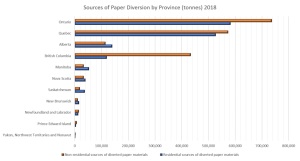Statistics Canada released the results of its biennial Waste Management Industry Survey: Business and Government Sector, containing waste diversion data for 2018.
The new data shows that Canadian households and businesses diverted 9,817,607 tonnes of waste in 2018, up 5.8% from 2016.
Of the total amount diverted, 3,519,689 tonnes were paper fibres (which includes newsprint, cardboard and boxboard, and mixed paper), representing 36% of the total amount diverted in 2018.
While paper diversion represents the majority of materials diverted from landfill in Canada, compared to previous years Statistics Canada data, paper diversion has been trending slightly down year over year since 2014.

The next leading category of materials diverted in Canada for 2018 was organics with 29% of the total share of diversion.

Digging deeper into paper diversion, of the 3.5M total tonnes diverted in Canada in 2018, about 44% was diverted through residential sources (ie. Blue Box recycling programs), while the remaining 56% was diverted through non-residential sources (ie. Industrial Commercial and Institutional collection).
Statistics Canada reported that Saskatchewan had the highest rate of residential paper fibre recycling among the provinces, at almost 70%, or 38,000 tonnes of its total 57,000 tonnes of paper recycling.
Below is a full breakdown of sources of paper diversion by province, for both residential and non-residential (IC&I) diversion. Of note, British Columbia had the highest IC&I paper fibre diversion rate at 78% (433,609 tonnes of its total 553,596 tonnes of diverted paper materials); while Ontario had the largest share of paper diversion by tonnage through both IC&I (736,790 tonnes) and residential (581,930 tonnes) sources.

Background on the Statistics Canada Data
Statistics Canada’s Waste Management Industry Survey of the business and government sectors is conducted every two years.
The 2018 results were released on March 8, 2021.
Some of the data contained in this blog are from Waste materials diverted, by type and by source (Table: 38-10-0138-01) which includes the following footnote:
This information covers only those companies and local waste management organizations that reported non-hazardous recyclable material preparation activities and refers only to that material entering the waste stream and does not cover any waste that may be managed on-site by a company or household. Additionally, these data do not include those materials transported by the generator directly to secondary processors, such as pulp and paper mills, while bypassing entirely any firm or local government involved in waste management activities.

Thanks for sharing the information with us, it was very informative